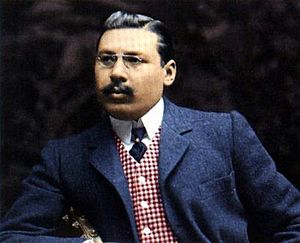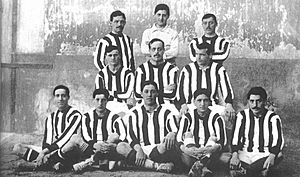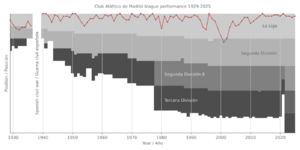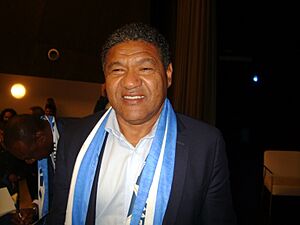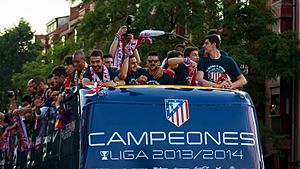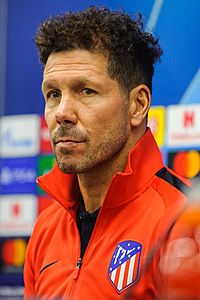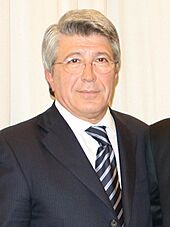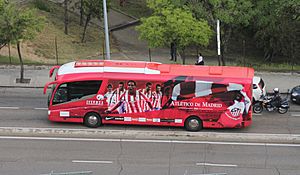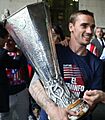Atlético Madrid facts for kids
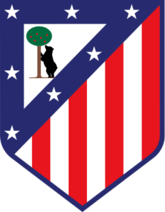 |
|||
| Full name | Club Atlético de Madrid, S.A.D. | ||
|---|---|---|---|
| Nickname(s) | Rojiblancos (The Red-Whites) Colchoneros (Mattress Makers) Indios (Indians) |
||
| Founded | 26 April 1903 (as Athletic Club de Madrid) | ||
| Ground | Estadio Riyadh Air Metropolitano | ||
| Capacity | 70,692 | ||
| Owner | Atlético HoldCo (65.98%) Idan Ofer (33%) |
||
| President | Enrique Cerezo | ||
| Manager | Diego Simeone | ||
| League | La Liga | ||
| 2022–23 | La Liga, 3rd of 20 | ||
|
|
|||
Club Atlético de Madrid, S.A.D. (often called Atlético Madrid or just Atlético) is a professional football club from Madrid, Spain. They play in La Liga, Spain's top football league. Their home games are played at the Riyadh Air Metropolitano, which can hold 70,692 fans.
The club started on April 26, 1903, as Athletic Club Sucursal de Madrid. They are famous for their red and white striped shirts. This look earned them nicknames like Los Colchoneros (The Mattress Makers) and Los Rojiblancos (The Red-Whites). In 1946, they became Atlético de Madrid. They have a big rivalry with their city neighbors, Real Madrid, in a match called El Derbi Madrileño. They also have a rivalry with Barcelona. Felipe VI, the King of Spain, has been the club's honorary president since 2003.
Atlético is one of Spain's most successful clubs. They have won 11 La Liga titles, including winning both the league and the cup in 1996. They also have 10 Copa del Rey titles and many European trophies. These include the European Cup Winners' Cup in 1962, the UEFA Europa League three times (2010, 2012, 2018), and the UEFA Super Cup three times (2010, 2012, 2018). They also won the 1974 Intercontinental Cup. In the UEFA Champions League, Atlético reached the final three times (1974, 2014, 2016).
Contents
- Club History: From Start to Now
- How Atlético Madrid Began (1903–1939)
- Atlético Aviación de Madrid (1939–1947)
- A Golden Era (1947–1965)
- Reaching European Finals (1965–1974)
- The Luis Aragonés Years (1974–1987)
- Changes and a Double Win (1987–2005)
- Torres Leaves and European Success (2006–2011)
- Simeone's Impact and New Success (2011–Present)
- Club Rivalries
- Club Trophies and Awards
- Players and Staff
- Club Ownership and International Connections
- Team Colors and Badge
- Team Nicknames
- Stadium and Training Facilities
- Kit Sponsors
- Fans and Supporters
- Notable Players
- Images for kids
- See also
Club History: From Start to Now
How Atlético Madrid Began (1903–1939)
The club was founded on April 26, 1903, by three students from the Basque region who lived in Madrid. They saw their new club as a younger version of their favorite team, Athletic Bilbao. In 1904, some players who left Real Madrid joined them.
At first, they wore blue and white shirts, just like Athletic Bilbao. But by 1910, both teams started wearing red and white stripes. Some people think this change happened because red and white striped fabric was cheap. It was used for mattress covers, and leftover cloth could easily be made into football shirts. This is how the club got its nickname, Los Colchoneros (The Mattress Makers).
Another story says that a former player, Juan Elorduy, went to England to buy kits. He couldn't find the usual blue and white ones, so he bought red and white shirts from Southampton. Athletic Madrid kept their blue shorts, while Athletic Bilbao changed to black shorts. This is why Athletic Madrid became known as Los Rojiblancos.
Atlético's first home ground was in a working-class area called Ronda de Vallecas. In 1921, Atlético Madrid became a separate club from Athletic Bilbao. They moved to a new stadium called the Estadio Metropolitano de Madrid, which could hold 35,800 fans.
In the 1920s, Atlético won the Campeonato del Centro three times. They also reached the Copa del Rey final twice, losing to Athletic Bilbao both times. Because of their success, they were invited to join the first La Liga in 1928. They were managed by Fred Pentland. After two seasons, they were relegated to the Segunda División (second division). They returned to La Liga in 1934 but were relegated again in 1936. The Spanish Civil War stopped football for a while, and Atlético got to stay in La Liga after winning a playoff.
Atlético Aviación de Madrid (1939–1947)
When La Liga started again in 1939, Atlético merged with a club called Aviación Nacional. This new team was called Athletic Aviación de Madrid. Aviación Nacional was formed by officers from the Spanish Air Force. They were given a spot in the top league because their stadium was destroyed in the war.
With the famous Ricardo Zamora as their manager, the club won their first La Liga title in 1940 and then again in 1941. A very important player during these years was captain Germán Gómez. He played for eight seasons and was part of a strong midfield.
In 1940, a rule was made that banned teams from using foreign names. So, the club changed its name to Atlético Aviación de Madrid. In September 1940, Atlético Aviación won the first Spanish Super Cup by beating RCD Español. On December 14, 1946, the club decided to remove the military part of its name. On January 6, 1947, they officially became Club Atlético de Madrid. In 1947, Atlético also beat Real Madrid 5–0, which is still their biggest win against their rivals.
A Golden Era (1947–1965)
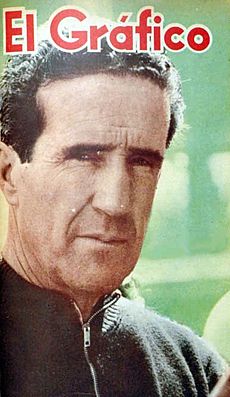
Under manager Helenio Herrera, and with the help of player Larbi Benbarek, Atlético won La Liga again in 1950 and 1951. After Herrera left in 1953, the club found it harder to compete with Real Madrid and Barcelona. For the rest of the 1950s, they were usually the third-best team in Spain, often battling with Athletic Bilbao.
However, in the 1960s and 1970s, Atlético Madrid became a strong challenger to Barcelona for the second-best team spot. In the 1957–58 season, Ferdinand Daučík led Atlético to second place in La Liga. This meant they qualified for the 1958–59 European Cup. Led by Brazilian player Vavá and Enrique Collar, Atlético reached the semi-finals, where they lost to Real Madrid.
Atlético got their revenge by beating Real Madrid in two Copa del Rey finals in a row, in 1960 and 1961. In 1962, they won the 1961–62 European Cup Winners' Cup, beating Fiorentina. This was a big achievement because it was a major European trophy that Real Madrid had never won. The next year, they reached the final again but lost to Tottenham Hotspur 5–1. Key players during this time included Enrique Collar, Miguel Jones, and Adelardo.
Atlético's best years often happened when Real Madrid was also very strong. Between 1961 and 1980, Real Madrid won La Liga 14 times. Atlético was the only team that truly challenged them, winning La Liga titles in 1966, 1970, 1973, and 1977. They also won the Copa del Rey three times in 1965, 1972, and 1976. In 1965, Atlético became the first team in eight years to beat Real Madrid at their home stadium, the Bernabéu.
Reaching European Finals (1965–1974)
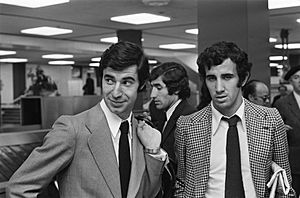
In 1966, Atlético moved from the Estadio Metropolitano de Madrid to their new home, the Vicente Calderón Stadium. It opened on October 2, 1966.
Important players from this time included the experienced Adelardo and goal scorers Luis Aragonés, Javier Irureta, and José Eulogio Gárate. Gárate was the top scorer in La Liga three times (1969, 1970, 1971). In the 1970s, Atlético also signed several Argentine players like Rubén Ayala and Panadero Díaz, and hired coach Juan Carlos Lorenzo. Lorenzo's strict style helped the team win La Liga in 1973. They then reached the 1974 European Cup final.
On their way to the final, Atlético beat teams like Galatasaray and Celtic. The final was against a very strong Bayern Munich team. Atlético played very well and scored a goal in extra time through Aragonés. But in the last minute, Bayern scored to make it 1–1. In a replay two days later, Bayern won 4–0.
The Luis Aragonés Years (1974–1987)
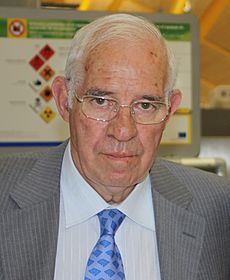
After the 1974 European Cup Final loss, Atlético hired their former player Luis Aragonés as coach. Aragonés coached the team four different times. His first success came quickly. Bayern Munich didn't want to play in the Intercontinental Cup, so Atlético, as the European Cup runners-up, took their place. They played against Independiente from Argentina. After losing the first game, they won the second 2–0 to lift the trophy. Aragonés then led the club to win the Copa del Rey in 1976 and La Liga in 1977.
During his second time as coach, Aragonés led the team to finish second in La Liga and win the Copa del Rey in 1985. Hugo Sánchez was a key player, scoring many goals. Sánchez scored twice in the cup final as Atlético beat Athletic Bilbao 2–1. However, Sánchez left for Real Madrid after just one season. Even without Sánchez, Aragonés helped the club win the Supercopa de España in 1985. He also guided them to the UEFA Cup Winners' Cup final in 1986, but they lost 3–0 to Dynamo Kyiv.
Changes and a Double Win (1987–2005)

In 1987, Jesús Gil became the club president. He spent a lot of money on new players, like Portuguese winger Paulo Futre. But this spending only brought two Copa del Rey trophies in 1991 and 1992. They came closest to winning La Liga in the 1990–91 season, finishing second to Johan Cruyff's Barcelona. Gil was known for changing coaches very often. He also closed Atlético's youth academy in 1992. This was a big deal because a 15-year-old academy player named Raúl then went to play for rivals Real Madrid and became world-famous.
In the 1994–95 season, Atlético almost got relegated. This led to more changes. But in the next season, 1995–96, with new coach Radomir Antić and players like Diego Simeone and Kiko, Atlético surprisingly won both the La Liga and the Copa del Rey. This was a famous "double" win. The next season, they played in the UEFA Champions League for the first time. They were knocked out in the quarter-finals by Ajax.
The 1999–2000 season was very bad for Atlético. The club president and board were suspended due to an investigation. The team played poorly and was relegated to the Segunda División (second division) for the second time in 66 years. They spent two seasons there before winning the Segunda División championship in 2002. It was Luis Aragonés, in his fourth time as manager, who brought them back to La Liga.
Aragonés also coached the team the next season and gave Fernando Torres his first game in La Liga. Torres was a very promising young player from the club's academy. In his first season (2002–03), he scored 13 goals. In 2003, Chelsea offered a lot of money for Torres, but Atlético refused. Torres continued to be a star player and became the club's youngest captain at just 19 years old.
Torres Leaves and European Success (2006–2011)

In 2006, Atlético signed Portuguese players Costinha and Maniche, and Argentine forward Sergio Agüero. In July 2007, Torres left for Liverpool. Atlético then bought Diego Forlán from Villarreal and Simão Sabrosa from Benfica.
In 2007, Atlético agreed to sell their stadium land and move to the city-owned Olympic Stadium. The 2007–08 season was very successful for the club. They reached the quarter-finals of the Copa del Rey and finished fourth in La Liga. This meant they qualified for the UEFA Champions League for the first time since 1997.
In February 2009, manager Javier Aguirre left the club. Abel Resino took over. Atlético finished fourth in the league again, securing another Champions League spot. Striker Diego Forlán was the top scorer in La Liga and won the European Golden Shoe with 32 goals.
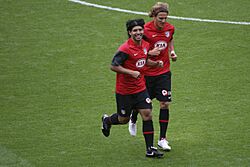
The 2009–10 season started badly. After a big loss to Chelsea in the Champions League, Abel Resino was replaced by Quique Sánchez Flores. With Sánchez Flores as coach, Atlético improved. They finished ninth in La Liga but did well in other competitions. They won the UEFA Europa League, beating Liverpool in the semi-finals and Fulham 2–1 in the final. Diego Forlán scored both goals in the final, including the winner in extra time. This was Atlético's first European trophy since 1962. They also reached the Copa del Rey final but lost to Sevilla. By winning the Europa League, they played in the 2010 UEFA Super Cup against Inter Milan and won 2–0.
The 2010–11 season was not as good, and manager Sánchez Flores left. He was replaced by Gregorio Manzano.
Simeone's Impact and New Success (2011–Present)
On December 23, 2011, Atlético hired their former Argentine player, Diego Simeone, as manager. The club had been changing managers often and losing young stars. Simeone was not very experienced as a coach, but he quickly changed Atlético into a very strong team. As a player, Simeone was known for being tough and determined. He brought that same winning attitude to the team. He focused on building a strong defense, with goalkeeper Thibaut Courtois and defender Diego Godín. His first six games as coach all ended with no goals scored against Atlético. Fans quickly loved Simeone because he was a key player when they won the league and cup double in 1996.
Simeone led Atlético to win their second Europa League title in three years. They beat Athletic Bilbao 3–0 in the final on May 9, 2012. Radamel Falcao scored two goals. By winning the Europa League, Atlético played in the 2012 UEFA Super Cup against Chelsea (the Champions League winners). Atlético won 4–1, with Falcao scoring three goals. On May 17, 2013, Atlético beat Real Madrid 2–1 in the Copa del Rey final. This ended a 14-year streak of not winning against Real Madrid.
On May 17, 2014, a 1–1 draw against Barcelona secured the La Liga title for Atlético. It was their first league title since 1996 and the first since 2004 not won by Barcelona or Real Madrid. One week later, Atlético played Real Madrid in their first Champions League final since 1974. They led 1–0 until the last minute of injury time, when Real Madrid scored to make it 1–1. Real Madrid then won 4–1 in extra time.
Antoine Griezmann joined Atlético in July 2014. He became Atlético's top scorer for five seasons in a row. He also became a world-class player, shining for the French national team. Atlético reached another Champions League final in 2016, again facing Real Madrid. They lost on penalties after a 1–1 draw.
The club played its last home game at the Vicente Calderón Stadium on May 21, 2017. They then moved to their new home, the Wanda Metropolitano (now Riyadh Air Metropolitano). In 2018, they won their third Europa League title by beating Marseille 3–0 in the final. Griezmann scored two goals. Atlético also won another UEFA Super Cup by beating Real Madrid 4–2 at the start of the next season.
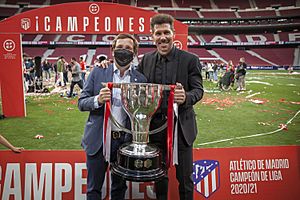
On September 25, 2020, Atlético signed Luis Suárez from Barcelona. Suárez had a huge impact, helping the team win the La Liga title again, seven years after their last one. He scored important goals in the final two games to secure the title. The final game of that season was a 2–1 win against Valladolid on May 22, 2021. On April 16, 2024, the team qualified for the 2025 FIFA Club World Cup for the first time.
Club Rivalries
Atlético Madrid vs. Real Madrid
Real Madrid and Atlético Madrid are two clubs with very different backgrounds. Real Madrid's stadium, the Santiago Bernabéu, is in a wealthy area of northern Madrid. Atlético's former stadium, the Vicente Calderón, was in a working-class area in the south.
Historically, Real Madrid has been seen as the club of the "establishment" or those in power. Atlético Madrid, on the other hand, has always been known for a "sense of rebellion." During the time of Francisco Franco's rule, the government used Real Madrid's European Cup wins to improve Spain's image around the world. This led to Atlético fans singing a song that calls Real Madrid "the government's team, the country's shame."
For a long time, Atlético Madrid struggled to beat Real Madrid. They had a 14-year streak without a win against them. But this changed on May 17, 2013, when Atlético beat Real Madrid 2–1 in the 2013 Copa del Rey final. They also won 1–0 against Real Madrid in September 2013.
The two teams faced each other in the 2014 and 2016 Champions League finals, with Real Madrid winning both times.
Atlético Madrid vs. Barcelona
There is also a historic rivalry between Atlético Madrid and Barcelona, which is considered one of the "Classics" of Spanish football. This rivalry has become more competitive since the early 2010s. Key moments include Atlético beating Barcelona in the 2016 Champions League. Also, Antoine Griezmann moved from Atlético to Barcelona in 2019 and then returned to Atlético in 2021. In 2020, Luis Suárez surprisingly moved to Atlético and played a big part in their league title win. However, the biggest rivalry for Atlético is still with their city neighbors, Real Madrid.
Club Trophies and Awards
Atlético Madrid has won many important titles:
- La Liga (Spanish League): 11 times
- 1939–40, 1940–41, 1949–50, 1950–51, 1965–66, 1969–70, 1972–73, 1976–77, 1995–96, 2013–14, 2020–21
- Segunda División (Second Division): 1 time
- 2001–02
- Copa del Rey (Spanish Cup): 10 times
- 1959–60, 1960–61, 1964–65, 1971–72, 1975–76, 1984–85, 1990–91, 1991–92, 1995–96, 2012–13
- Supercopa de España (Spanish Super Cup): 2 times
- 1985, 2014
- Copa Presidente FEF: 1 time
- 1941-47
- Copa Eva Duarte: 1 time
- 1951
- UEFA Europa League: 3 times
- 2009–10, 2011–12, 2017–18
- UEFA Cup Winners' Cup: 1 time
- 1961–62
- UEFA Super Cup: 3 times
- 2010, 2012, 2018
- Intercontinental Cup: 1 time
- 1974
They have also won regional titles like the Campeonato de Madrid/Campeonato Regional Centro (4 times) and Copa Federación Centro (1 time).
Awards and Recognitions
- Copa Stadium (Spain's oldest National Sport Award): 1962
- Gold Medal (Royal Order of Sports Merit): 2014
- Globe Soccer Special Award: 2014
- Globe Soccer Best Club of the Year: 2012, 2018
- IFFHS The World's Club Team of the Year: 2018
Players and Staff
Spanish teams can have only three players who are not from the European Union (EU). Some non-European players might have dual citizenship with an EU country, so they don't count towards this limit.
Current Squad
|
|
Reserve Team
Other Players Under Contract
|
Players Out on Loan
|
Technical Staff
| Position | Staff |
|---|---|
| Head coach | |
| Assistant coaches | |
| Goalkeeping coach | |
| Fitness coach | |
| Physiotherapists | |
| Rehabilitation physios | |
| Technical assistant Team | |
| Team delegate | |
| Head of medical department | |
| Club doctor | |
| Doctor | |
| Technical team | |
Source: Atlético Madrid
Club Ownership and International Connections
Enrique Cerezo has been the club president since 2003. Miguel Ángel Gil Marín, the son of a former president, is the chief executive officer. As of 2021, Gil Marín, Cerezo, and a company called Ares Management Corporation own most of the club (66.98%) through 'Atlético HoldCo'. Israeli businessman Idan Ofer owns 33% of Atlético Madrid.
Atlético also partly owns other football clubs around the world. These include Liga MX club Atlético San Luis in Mexico and Canadian Premier League side Atlético Ottawa in Canada. The club used to partly own an Indian Super League team in Kolkata, called Atlético de Kolkata, which won the league twice. However, Atlético ended its partnership with that club in 2017.
In October 2018, Atlético de Madrid opened its first football academy in Pakistan, located in Lahore. This was the first European football academy in Pakistan. They also started a "Football School Program" there in April 2019. In February 2020, Atlético Madrid Lahore became a professional Pakistani football club.
Team Colors and Badge
Atlético's home kit features red and white vertical striped shirts, blue shorts, and blue and red socks. They have used this combination since 1910.
The club's badge, first used in 1917, shows the Coat of arms of Madrid. It was added to the team's jersey in 1947. The badge was updated in 2016, but on June 30, 2023, club members voted to bring back the older, historical badge. This change will happen on July 1, 2024.
Team Nicknames
Over the years, the club has had several nicknames:
- Los Colchoneros ("The Mattress Makers"): This nickname comes from their red and white striped shirts, which were the same colors as traditional mattresses.
- Los Indios ("The Indians"): This nickname became popular in the 1970s. Some people think it's because the club signed many South American players after rules about foreign players changed. Other ideas are that their stadium was "camped" by the river, or that "The Indians" were the traditional rivals of "The Whites" (Real Madrid).
Felipe VI, the King of Spain, has been the honorary president of the club since 2003.
Stadium and Training Facilities
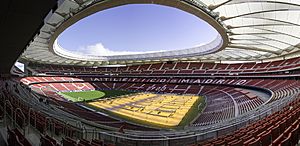
The club plays its home games at the Riyadh Air Metropolitano. This stadium was expanded from 20,000 seats to 68,000 seats. It was used for Madrid's attempt to host the 2016 Summer Olympics. After the stadium was renovated, Atlético played its first game there against Málaga. Antoine Griezmann scored the first goal at the new stadium.
Training Ground
The club's training ground is the Ciudad Deportiva Atlético de Madrid in Majadahonda, about 20 kilometers west of Madrid. It has grass and artificial pitches, plus a gym. Both the main team and the youth teams train there.
Atlético also has a sports academy at the Ciudad Deportiva del Nuevo Cerro del Espino in Majadahonda. They also run an academy in Bucharest, Romania, which is their first in Europe.
Kit Sponsors
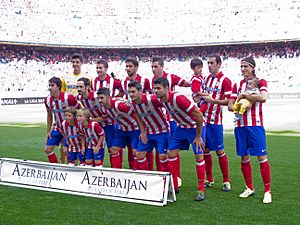
Atlético started playing in blue and white, like their parent club Athletic Bilbao. But by 1911, both clubs switched to red and white stripes, which became their traditional colors. This change happened because red and white striped fabric was cheap, as it was also used for bed mattresses. Nike has made the team's kits since 2001.
From 2012 to 2014, the government of Azerbaijan sponsored the club's main shirt, with the slogan 'Land of Fire'. This sponsorship was criticized by some groups because of concerns about human rights in Azerbaijan. Atlético Madrid said the goal was to "promote the image of Azerbaijan."
In the 2003–04 season, Columbia Pictures sponsored the club. They would change the sponsor's logo on the shirt, and sometimes even the shirt itself, to promote different movies. For example, when Spider-Man 2 was in cinemas, the shirt featured that movie. This deal included 16 different movie titles, which was a lot! Because shirts would change so quickly, Nike decided not to put a sponsor's logo on replica shirts sold to fans from 2003 to 2005.
| Period | Kit manufacturer | Shirt Sponsors |
|---|---|---|
| 1950-80 | Deportes Cóndor | None |
| 1980–86 | Meyba | |
| 1986–89 | Puma | |
| 1989–90 | Mita | |
| 1990–93 | Marbella* | |
| 1993–94 | Antena 3 | |
| 1994–96 | Marbella* | |
| 1996–97 | Bandai/Tamagotchi | |
| 1997–98 | Marbella* | |
| 1998–99 | Reebok | |
| 1999–2000 | None | |
| 2000–01 | Idea | |
| 2001–03 | Nike | |
| 2003–05 | Columbia Pictures** | |
| 2005–11 | KIA | |
| 03–05 2012 | Rixos Hotels (Liga only, except v. R. Madrid) | |
| 05–12 2012 | Huawei | |
| 2012–14 | Azerbaijan Land of Fire | |
| 2014–15 | Baku 2015 | |
| 2015–22 | Plus500 | |
| 2018– | Hyundai (co-sponsor) | |
| 2019– | Ria Money Transfer (co-sponsor) | |
| 2022–2023 | WhaleFin | |
| 2023– | Riyadh Air |
- (**) – 2003–05 Columbia Pictures (Movies advertised on the shirt included Bewitched, Hollywood Homicide, S.W.A.T., Big Fish, Hellboy, Spanglish, Resident Evil 2: Apocalypse, Hitch, xXx and Spider-Man 2).
Fans and Supporters
Frente Atlético is a large fan group of Club Atlético de Madrid, started in 1982. In 2014, they had about 2,500 members. That same year, Atlético Madrid banned Frente Atlético and their symbols from the stadium.
This group has friendships with fans from other clubs like Ruch Chorzow, Roma, and Sporting Gijón. They also have big rivalries with fan groups from Real Madrid, Sevilla, Valencia, and many other teams.
Many famous people are fans of Atlético Madrid, including actors Javier Bardem, Will Smith, Harrison Ford, Halle Berry, Tom Cruise, Matt Damon, Vin Diesel, and Charlize Theron. Basketball player Karl-Anthony Towns and King Felipe VI are also supporters.
Atlético Madrid has become one of the most popular sports clubs globally, with many fans around the world. As of October 6, 2024, Atlético was the 16th most popular sports club on Instagram worldwide.
Notable Players
Koke has played more than 680 matches for Atlético since 2009, which is the most appearances for the club. Antoine Griezmann holds the record for most goals, with 198. João Félix was the club's most expensive signing at €126 million, and Antoine Griezmann was the club's biggest sale at €120 million.
|
|
Images for kids
-
Helenio Herrera led Atlético to two league titles as manager.
-
José Eulogio Gárate and Javier Irureta were key attackers when Atlético reached the 1974 European Cup final.
-
Luis Aragonés, Atlético's most successful manager.
-
Radomir Antić managed Atlético three times, winning a league and cup double in 1996.
-
Fernando Torres, who started his career at Atlético, had great success with the Spain national team.
-
Atlético fans during a Madrid derby in February 2007 at the Vicente Calderón Stadium.
-
Atlético's strong attacking duo: Sergio Agüero (left) and Diego Forlán (right). Forlán won the European Golden Shoe in 2009.
-
Diego Simeone has led the club to two UEFA Champions League finals.
-
Antoine Griezmann, Atlético's all-time top scorer, with the UEFA Europa League title in 2018.
-
Simeone celebrating the La Liga title win in 2021.
-
The Riyadh Air Metropolitano, home of Atlético.
-
Atlético players wearing kits with "Azerbaijan Land of Fire" as a sponsor.
See also
 In Spanish: Club Atlético de Madrid para niños
In Spanish: Club Atlético de Madrid para niños


